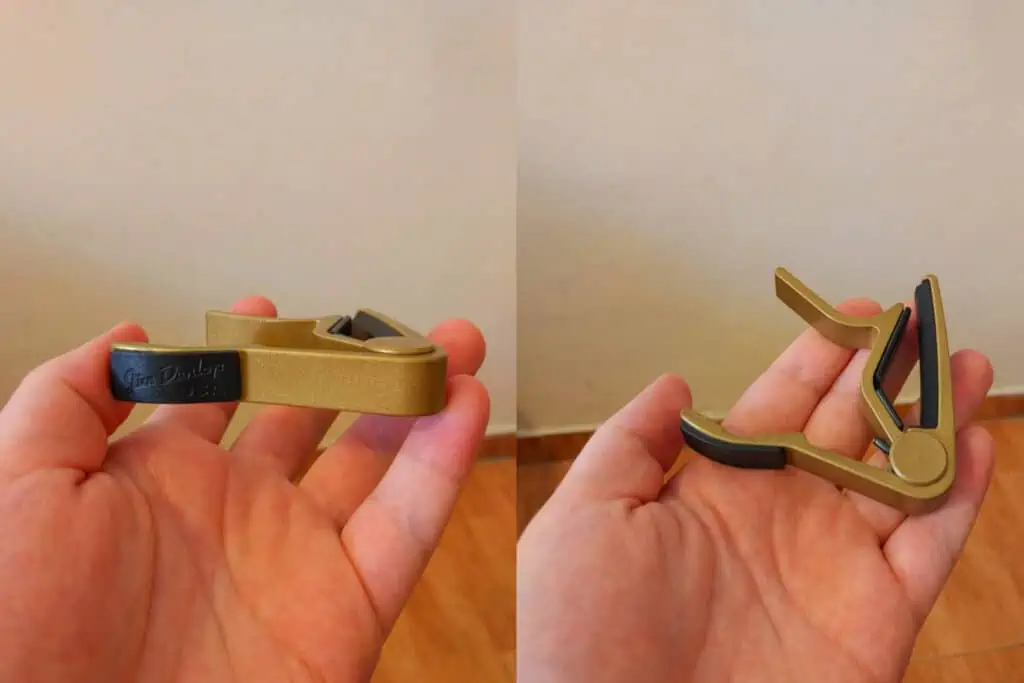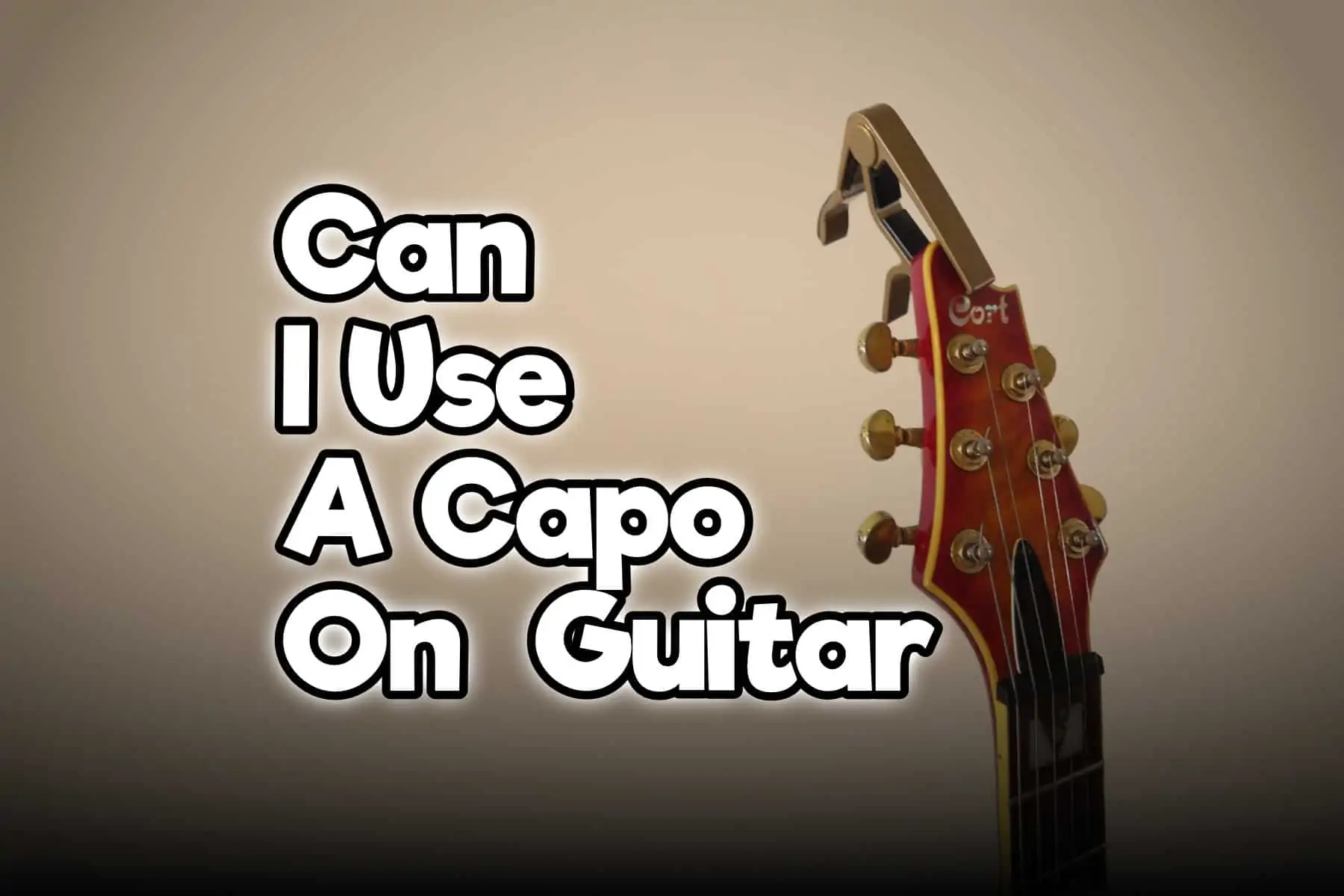Capo or capodaster is a great little tool that could help you in your guitar playing. It is used to shorten the string length and to allow you to play open chords in different keys even if your guitar is in standard tuning. One of the main advantages of the capo is that you can use the same fingerpicking pattern, for example, instead of having to relearn the song again.
But can you use a capo on electric, classical, or acoustic guitar? The answer is yes. You can use it on any guitar you can imagine. While it is not that common to see an electric guitar with a capo, it is still something you could do with ease.
The truth is that capo can be used on almost any type of guitar, but there are several things that you should know. Naturally, there are also different types and brands, and some of them might be a better choice for you.
What Happens When You Put A Capo On The Guitar
If you are using standard tuning, the sixth string or the thickest one will be E. When putting a capo on, let’s say, the third fret, you will change the pitch to G. Of course, you could use any tuning you want, and place capo wherever you want. But the point is that you will create the same effect as if you fretted the entire neck somewhere. This way, you will have the option of using open chords instead of a barre.
In the example we mentioned, you would have an E# (E sharp) chord that would actually be G, A# would be C, and so on. You will shorten each string depending on the position of the capo and will be able to play chords as if the song was in E, and you needed open chords.
The reason for this is to allow the player to use open chords if there is a part of the song that would require additional corrections and adjustments. The songs that had specific picking patterns that would otherwise be a lot more difficult to play are perfect for capo. Instead of relearning the entire pattern in a different position, you would simply shorten the string length and continue playing.
Furthermore, sometimes you’ll be in a situation where you have to change the key for whatever reason. Usually, it is done to help the singer with a difficult key to finding the one that’s more suitable. And it is much easier to place capo than to change the tuning for one song. Plus, sometimes it will happen that you’ll have to change the tuning for more than one step, and it won’t be possible to tune the guitar this way without the strings breaking.
If you know what barre chords are, then you can imagine capo being your index finger. Using it will replace the need to fret all six strings and make it easier to play some songs. It is especially useful for beginners who still struggle with chords like F# or B minor.
How To Use Capo For Beginners

Capo is easy to use, and it won’t take you long to figure out how to place it properly. It is a simple clamp that when placed on the neck will press on all six strings. If you figured out where you want to place it, all you’ll need to do is to press the two near ends and clamp the string, similar to how clothespin works.
As you can imagine, it won’t take you longer than a few seconds to put the capo on (or remove it). This is one of the main advantages of this tool, and the ability to change the key in a few seconds only.
While many beginners have issues with the capo, and the most common mistake is placing it unevenly. What you want to do is to make sure that all strings are pressed equally and that capo slightly behind the fret bar. Otherwise, you might change the tuning slightly, and make chords sound out of tune, even if your guitar is properly tuned.
Of course, it might sound complicated, but it is something that you will master with a little practice. In the end, it is a lot easier to use a capo than to play barre chords.
Can Capo Damage My Guitar
One of the most common questions is if capo can somehow damage the guitar. Unfortunately, the answer is yes. If you find a cheap capo, it will damage your guitar. Among the main problems that capo can cause is the damage to the finish of the guitar. While the strings are pressed on the fretboard, the other part of the capo is pressing from the opposite side on the neck, where it’s clamped.
If you find the cheap capo, it might destroy the finish on the neck, especially if used for a longer period of time. While it is not a common thing to happen, you should make sure that you find a proper capo that has protection and won’t destroy the backside of the neck. Most of the capo has a softer side of the clap that is placed where your thumb would be. These are good, and if the edge is soft, then there won’t be any damage to the neck of the guitar.
Furthermore, you should make sure that you don’t scratch the finish while putting it on and off. It is also worth mentioning that capo will have a somewhat impact on the strings and their lifespan. While it is not something that is important, and you won’t have to change strings daily because you use capo, it is still something we should mention.
Finally, if you don’t find a bad capo, there will be almost no damage to the guitar with proper use. However, be sure that you don’t find the cheap ones without protection for the backside of the neck.
Things You Shouldn’t Do When The Capo Is On The Guitar
There are several things that you should not do when the capo is on the guitar. These are important to remember if you want to avoid damage to your instrument.
Don’t Tune The Guitar When The Capo Is On
You should consider this to be rule number one. Whatever you do, don’t tune your guitar with a capo. Since the strings are already fretted at someplace depending on where you place the capo, tuning them might cause them to break or to simply fail to tune the guitar.
Since putting the capo on and off is easy, you should just remove it, and tune the guitar without it. This way, you can be sure that there is no extra tension placed on the strings. However, if your guitar is perfectly tuned and goes out of tune when you place capo, there are two things that might be the problem. You are either placing the capo incorrectly (uneven or you bent a string), or your guitar has some issues with intonation. Whatever the issue may be, there is absolutely no reason to tune the guitar with a capo on.
Don’t Leave The Capo On The Guitar
One of the important issues is about using capo too much. While it is perfectly normal to play the guitar for a while with the capo on, you should never leave on the guitar when you are not playing. The acoustic guitars already have so many issues with the tension, and you creating more will be of no help at all.
Furthermore, this additional tension can lead to neck warping. While electric guitars have a truss rod inside the neck, acoustic guitars rarely do. You don’t want to put more tension than it’s already placed. Finally, you might ruin the capo as well. Of course, this is not nearly as important as the neck of the guitar, but you could still prolong the life of your capo.
It is worth mentioning that similar to the previous part, you can damage the finish of the guitar, or cause additional fret wear by leaving the capo too long. When you play the chords without the capo, you would intentionally or unintentionally move the strings a bit even while playing the chords, and if you use vibrato, that would be even better. The reason is that the frets will wear evenly and there won’t be dents and holes under each string.
Do Capos Fit All Guitars
Capos will usually fit all standard guitars. However, you might not be able to use it on seven-strings guitar or if you have the one with eight or more strings. The capo will be too short to clamp all of the strings, and you might need to find a custom one. However, if you play a regular six-stringed guitar, it’s almost unlikely that you will find a capo that is unfit for your guitar.
The Best Guitar Capo I Personally Use
There are so many choices for a capo and you can always find something you like better. However, I would recommend taking something from a well-known brand and one that has padding that none of the metal parts will touch the guitar’s wood.
Jim Dunlop Capo

Dunlop’s been around for a long time. They are undoubtedly one of the best manufacturers in the world and they make so many things for our instruments. If you notice I use the one which is labeled for acoustic guitar, but it suits for an electric guitar as well. This has a strong clamp which is made from aircraft aluminum. While using it I didn’t notice any string buzzing both on electric or acoustic. Available on Amazon under $15.
if you are looking for your next gear or an accessory that can improve your playing experience but you are not sure what it is exactly, make sure to check my post Top 27 Must Have Guitar Accessories For Every Guitarist
If you found this article useful, you may want to save this pin below to your Guitar board.

Recent Posts
When learning new songs have you noticed that some of the chord sequences sound really good? But when you tried to come up with your own chord sequence, or as we call it chord progression, you found...
Some guitarists insist on buying an expensive amplifier with their electric guitar. They assume that this is a must for every type of guitarist out there. However, in some situations, this isn’t...

